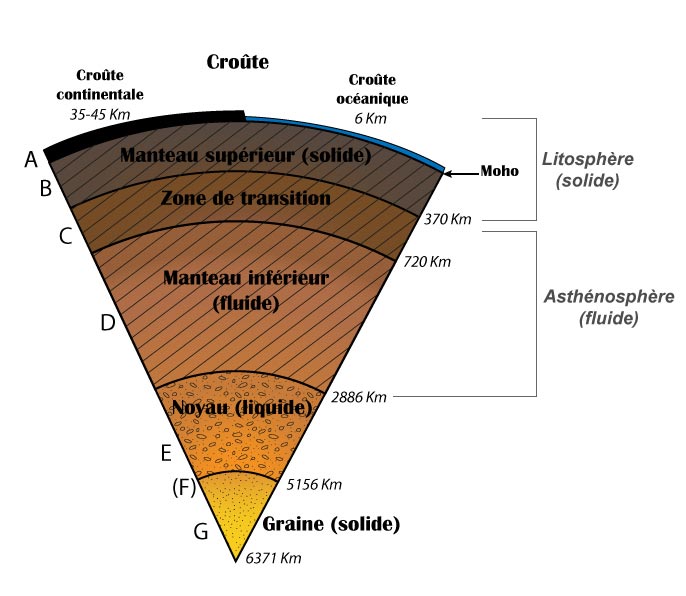Internal structure of our planet Earth
PDFThe structure of the Earth is revealed in part by seismology, and more precisely by the study of the propagation of waves generated by large earthquakes. These elastic waves propagate inside the Earth in two modes. The first involves compression vibrations in the direction of wave propagation; it corresponds to P waves. The second involves shear vibrations perpendicular to the direction of propagation of these waves; it corresponds to S waves. P waves propagate in the Earth at the highest propagation rate. They are therefore the First to be observed after an earthquake, hence their name P. Shear waves propagating more slowly arrive in Second, hence their name S waves.
The analysis of the arrival times of these waves at various points on the Earth’s surface after earthquakes of magnitude greater than 7 (dynamic failure dimensions greater than 30 km) revealed four successive layers, moving from the Earth’s surface towards its centre.
The outermost layer is called the earth’s crust. Its thickness varies from 4 to 5 km under the oceans to about 50 km under the continents. It is limited by the discontinuity of Mohorovicicic (more commonly known as Moho). Below the Moho, waves propagate much more quickly due to a variation in mass density due to the chemical composition of the materials encountered. This material has a relatively homogeneous chemical composition and is called the mantle.
Due to the pressure and temperature increases that occur as we approach the centre of the Earth, the mantle exhibits two types of mechanical behaviour. Its outermost part exhibits solid-type behaviour while its innermost part exhibits fluid-type mechanical behaviour (or more precisely incompressible highly viscous liquid that does not withstand shearing over the very long term). The earth’s crust and the solid part of the mantle form what is called the lithosphere, while the deep part of the mantle, which behaves like a fluid, is called the asthenosphere. Below the asthenosphere, at a depth of about 2900 km, there is a further increase in the speed of the P waves and the disappearance of the S waves. The seismic waves then penetrate into the nucleus with liquid-like behaviour (very low viscosity incompressible liquid that does not transmit the shear waves). At a depth of 5150 km, the materials encountered become solid again. They constitute the seed to the centre of the earth at a depth of 6371 km.

The temperature at the asthenosphere – nucleus boundary has been estimated at 2230°C [1], while the temperature at the centre of the earth exceeds 5000°C. Due to their fluid behaviour, both the outer nucleus and the asthenosphere are the site of significant convection movements that profoundly influence the mechanics of the overlying lithosphere. They are an important element influencing tectonic movements affecting the earth’s crust, and therefore also regional seismic and volcanic activity.
References and notes
Cover image. Internal structure of the globe. [Source: Drawing by Doc Carbur 2005]
[1] Stacey F.D., 1977. A thermal model of the Earth, Phys. Ear. Plan. Int., vol. 215, pp 341-348.




